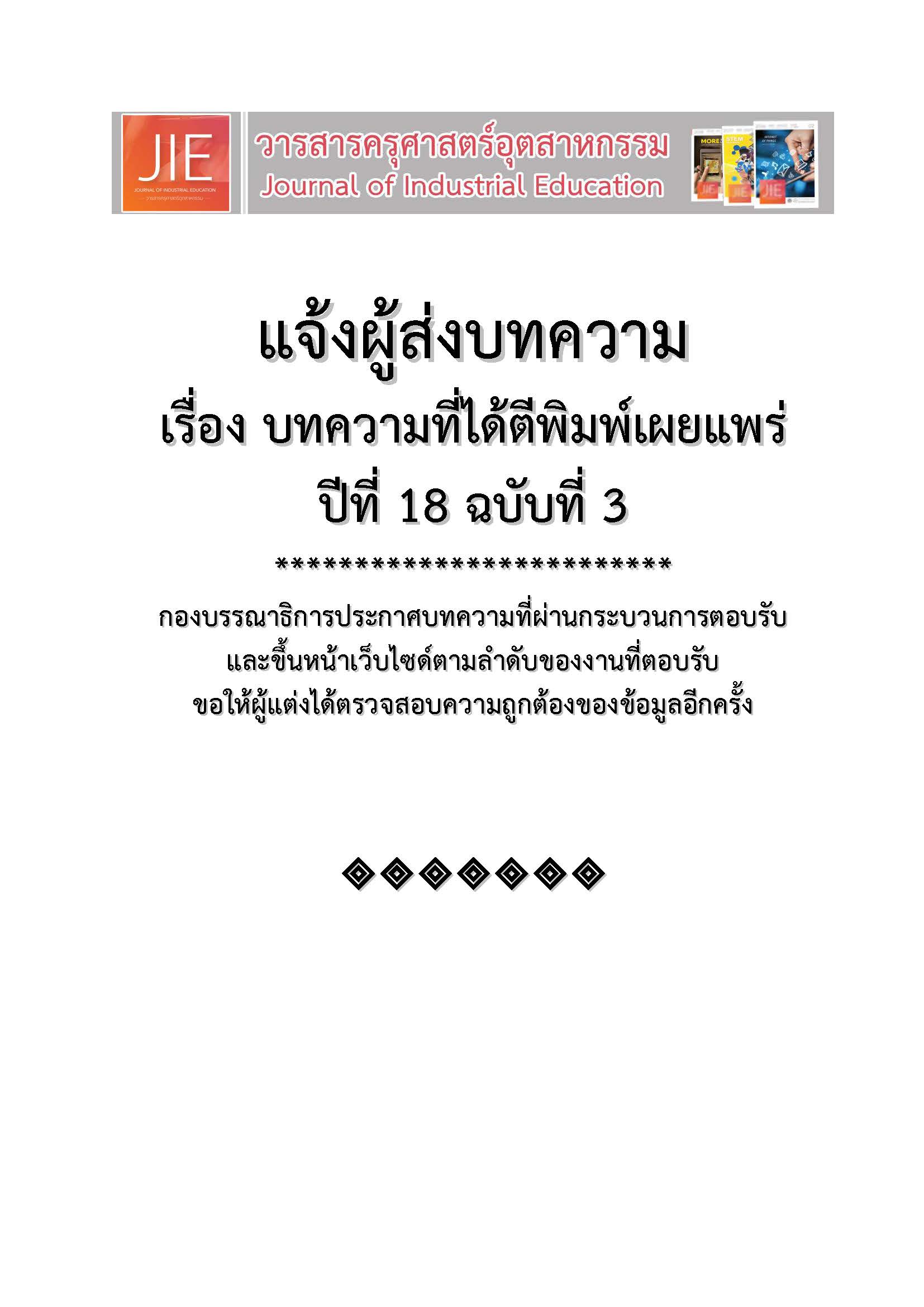A COMPARISON OF GRADE 9 STUDENTS’ LEARNING ACHIEVEMENT AND ANALYTICAL THINKING ABILITIES ON GENETICS USING THE 4MAT LEARNING MANAGEMENT AND VEE DIAGRAM LEARNING MANAGEMENT
Keywords:
4MAT learning management, Vee diagram learning management, Learning achievement, Analytical thinking abilitiesAbstract
The purposes of this research were: 1) to investigate the efficiency of science lesson plans on the topic of genetics for grade 9 students by using 4MAT learning management and Vee diagram learning management according to the efficient criteria of 80/80, 2) to compare grade 9 students’ learning achievement between groups taught by 4MAT learning management and Vee diagram learning management, and 3) to compare grade 9 students’ analytical thinking abilities between groups taught by 4MAT learning management and Vee diagram learning management. The samples of this study were 84 grade 9 students who enrolled in the first semester of 2018 academic year at an extra large secondary school in Bangkok. These students were randomly selected by cluster random sampling method and divided into 2 groups. The research instruments consisted of 1) 4MAT lesson plans, 2) Vee diagram lesson plans, 3) a learning achievement test with item difficulty ranging from 0.33 to 0.61, item discrimination ranging from 0.22 to 0.56, and reliability of 0.94, and 4) an analytical thinking ability test with item difficulty ranging from 0.33 to 0.69, item discrimination ranging from 0.22 to 0.66, and reliability of 0.96. The data were analyzed by means, standard deviation, t-test for independent samples.
The results of this study revealed as follow: 1) the efficiency (E1/E2) of lesson plans with 4MAT learning management and Vee diagram learning management indicated an efficiency of 86.82/83.47 and 85.25/81.10 respectively, which were higher than the criteria of 80/80, 2) there was no statistically significant difference in students’ learning achievement between group taught by 4MAT learning management and group taught by Vee diagram learning management, and 3) there was no statistically significant difference in students’ analytical thinking abilities between group taught by 4MAT learning management and group taught by Vee diagram learning management.
References
Prapansiri Susaorat. 2013. Thinking Development. Bangkok: 9119 Technic Printing LP.
Ministry of Education. 2008. Basic Education Core Curriculum B.E. 2551 (A.D. 2008). Bangkok: The Agricultural Co-operative Federation of Thailand Press.
The Institute for the Promotion of Teaching Science and Technology. 2017. Basic Summary of PISA 2015. Bangkok: The Institute for the Promotion of Teaching Science and Technology. Online Document.
National Institute of Educational Testing Service. 2018. Summary of Ordinary National Education Test Report of the 2560 Academic Year. [online]. Retrieved from https://www.newonetresult.niets.or.th/AnnouncementWeb/PDF/SummaryONETM3_2560.pdf (October 03, 2019).
Sasithorn Wiangwalai. 2013. Learning Management. Bangkok: O.S. Printing House.
Monhathai Chanthunyakum. 2011. The Effect of Using Vee Diagrams of Mathayomsuksa I Students’ Mathematical Problem Solving Ability and Communication Skill in Word Problems of Linear Equations in One Variable. Master of Education Degree in Secondary Education, Srinakharinwirot University.
Tisana Khammani. 2009. Sciences of Teaching: Body of Knowledge for Effective Learning Procedure. Bangkok: Chulalongkorn University Press.
Chumpon Chareesean and Phairoth Termtachatipongsa. 2012. Grade 9 Students’ Scientific Conceptual Understanding of “Life and Environment” from Vee Heuristic Learning Method. Journal of Education Khon Kaen University, 35(4), p. 20–26.
Novak, J. D., Gowin, D. B., and Kahle, J. B. 1984. Learning How to Learn. Cambridge: Cambridge University Press.
Chadawan Sukhamsri, Mayuso Kuno and Chatchadaporn Pinthong. 2018. Development of Learning Management using Scientific Representations in Stoichiometry for High School Students. Journal of Industrial Education, 17(3), p. 47–53.
Pattana Thaporn, Sutep Thongpradid and Montri Anantarak. 2013. Comparison of MathayomSuksa 1 Students’ Learning Achievements and Scientific Problem Solutions on Thermal Energy through 4-MAT Learning Activity versus Teaching a Quest Following the IPST Type. Nakhon Phanom University Journal, 3(2). p. 41–47.
Rungsinee Sutikad, Tatsana Prasantree and Montree Anantarak. 2014. A Comparison of Achievements in Learning on Living Things and the Environment and of Science Process Skills among Prathom Suksa 6 Students through Learning Management Approaches Using 4 MAT versus Inquiry. Nakhon Phanom University Journal, 4(1), p. 37–44.
Mariam Watthanard, Chade Sirisawat and Sutin Kingtong. 2016. A Comparison of Inquiry Based Learning with Vee Diagram and Conventional Approach on Learning Achievement and Integrated Science Process Skills in Topic of Nervous. Journal of Research Unit on Science, Technology and Environment for Learning, 7(2). p. 254–264.
Thitirat Punyayao and Virapong Saeng-Xuto. 2018. Effects of Inquiry Method with V Diagrams to Promote Critical Thinking of Mathayomsuksa 2 Students. FEU Academic Review Journal, 12(2), p. 100–114.
Suwannee Sangartit, Thunyaporn Cheunklin and Chutima Teanchaithut. 2016. The Effects of 4MAT Teaching on Analytical Thinking Ability of Third Year Nursing Students at Prachomklao College of Nursing, Phetchaburi. Journal of Health Science Research, 10(2), p. 82–91.
Downloads
Published
How to Cite
Issue
Section
License
"The opinions and contents including the words in papers are responsibility by the authors."
"ข้อคิดเห็น เนื้อหา รวมทั้งการใช้ภาษาในบทความถือเป็นความรับผิดชอบของผู้เขียน"



